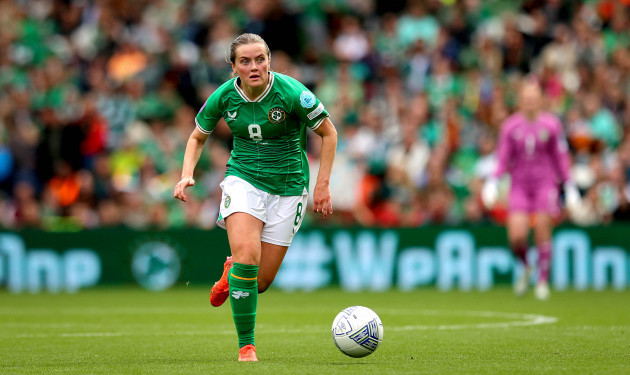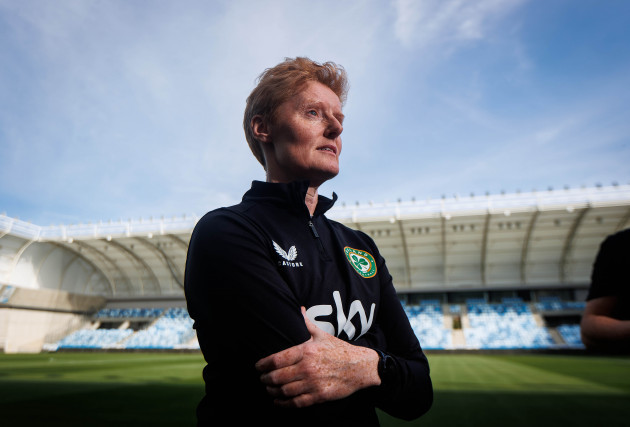TWO WINS, TWO clean sheets, six points and top of Group B1 of the Uefa Women’s Nations League.
Interim Republic of Ireland head coach Eileen Gleeson has overseen a successful start to a new campaign with quick-fire victories over Northern Ireland (3-0) and Hungary (4-0).
From a record crowd of 35,944 on an historic occasion at the Aviva Stadium on Saturday to a professional showing in Budapest last night, it’s been a positive few days.
Here’s five talking points from the Nations League double-header.
1. Next chapter up and running
The Vera Pauw era is firmly in the past, for better or for worse. Gleeson has steadied the ship through a positive start to the next chapter, impressively completing the task at hand and laying solid foundations.
The return of Tyler Toland, her two starts and her Player of the Match performance certainly bookended the Pauw days; the Donegal midfielder previously enduring a four-year international exile after a public falling out with the former manager.
A messy fallout followed Pauw’s departure, but the FAI drew a line under it all in Saturday’s match programme. CEO Jonathan Hill and President Gerry McAnaney both mentioned the history-making Dutchwoman in their programme notes, with this passage also included:
“The Football Association of Ireland would like to thank Vera Pauw for her time in charge of the Ireland Women’s National Team from 2019 to 2023. In that period, Vera oversaw 24 games that included a record win (11-0 versus Georgia), a biggest homes attendance (7,633 versus France), highest Fifa World Ranking position (22) and qualification for the World Cup. Vera helped to raise the profile of the team — and women’s football in general — and she will forever have a place in Irish footballing history because of that. Thank you Vera!”
2. New and returning faces
Toland was the standout name in Gleeson’s squad. “It’s like she never left,” captain Katie McCabe said in the build-up to the Northern Ireland game, and we saw her seamlessly slot back into the middle in both games.
“She gives us great balance and she’s composted on the ball,” Gleeson said. “That allows us to play in a different way.”
But Caitlin Hayes stole the show somewhat on her late arrival, following up a hugely impressive debut against the North with her first international goal against Hungary. An assured, ball-playing centre-half, she slotted into the back three alongside Louise Quinn and Diane Caldwell on both occasions and posed a huge aerial threat.
“You’ve seen Caitlin, she’s walked in, taken over the place, straight on, really dominant performance defensively, in possession composed on the ball, gave us lots of out ball for our forwards,” as the interim boss remarked.
Emily Whelan returned with a brief cameo, while Savannah McCarthy, Éabha O’Mahony, Saoirse Noonan and Hayley Nolan are back in and around the set-up. Jamie Finn also made a welcome comeback on the field after being overlooked for the final World Cup squad.
3. System change and more attacking style
Gleeson has moved from Pauw’s trusty 5-4-1 to a 3-5-2 or perhaps a 3-4-1-2. Both starting XIs saw Lucy Quinn playing off Kyra Carusa up top, with Denise O’Sullivan at her brilliant best behind them in the 10. Toland was joined by Megan Connolly, and then Lily Agg, in the middle, while McCabe and Heather Payne remained the wing-backs, though played higher up the pitch.
Albeit against weaker opposition than before, Ireland found great joy from their new approach with the players hailing it in post-match interviews. “We’re really enjoying the football right now,” O’Sullivan said last night.
It has yielded more goals, with variation in attack. Uncharacteristically, all four goals against Hungary came from open play. Just one of their other seven in 2023 — Carusa’s against Northern Ireland — arrived in that capacity, with the others directly from, or off the back of, set-pieces.
“Multiple people putting goals in the back of the net and being on the scoreboard, I mean it just shows the depth and the ability of this team and it really builds confidence amongst us and amongst our playing style,” the US-born striker told RTÉ.
“Off a cross, near post runs, cutbacks, just being clinical in the final third, it’s everything that we want to continue to build on. We’ve only had 10 days to build that in us. You can just see that it’s clicking pretty well for us.”
Notably also, the favourites tag didn’t weigh heavily and Ireland didn’t struggle to break down lower-ranked opposition like they often have in the past.
4. Squad depth and competition
The injury/unavailable list at the outset of this camp was striking: Niamh Fahey, Megan Campbell, Aoife Mannion, Jessie Stapleton, Claire Walsh, Tara O’Hanlon, Roma McLaughlin, Jess Ziu, Sinead Farrelly and Leanne Kiernan.
Ruesha Littlejohn’s withdrawal was another blow, with World Cup bolter Izzy Atkinson getting the nod. Atkinson was a second-half substitute in both games, making her impact felt against Hungary in particular. That’s just one example of the strength and depth in this squad.
Abbie Larkin and Amber Barrett were handed opportunities off the bench, alongsidee others mentioned before, with competition heating up across the field. Central defence is one key area, with experienced trio Quinn, Fahey and Caldwell being pushed all the way by Hayes, Mannion, McCarthy, Campbell, Stapleton, Nolan and Claire O’Riordan.
“Over the last few years, we’re creating a squad in terms of really improving the strength and depth of the team,” as McCabe told RTÉ. “There’s players going and playing abroad, really challenging themselves and it only brings you more challenging environments, we have to do our best and there’s competition for places now.
“That’s what we want. It’s international level, we want to be at our best coming in and making sure we’re getting the best players on the park.”
5. What’s next?
Group minnows Albania are Ireland’s next opposition in a double-header in late October. They drew 1-1 with Hungary, and fell to a 1-0 defeat to Northern Ireland in recent days. The first game is currently fixed for Tallaght Stadium on Friday 27 October, with the away clash four days later.
Calls will undoubtedly heighten for an Aviva Stadium return after Saturday’s record-breaking occasion, but it’s unlikely to happen this time around. It certainly won’t be the last time the Girls In Green play at Lansdowne Road, however.
In early December then, they host Hungary and make the short trip to Belfast to round out their group games against Northern Ireland. A clean sweep is the expectation: six wins from six to top the group and achieve promotion to League A of the European Championship qualifiers, boosting their hopes of reaching a second major tournament.
Whether Gleeson and her interim staff will be at the helm for the October and December windows remains to be seen, with the FAI Head of Women’s and Girls Football staying coy on her future.
Whatever happens, the next chapter is underway on a high.





